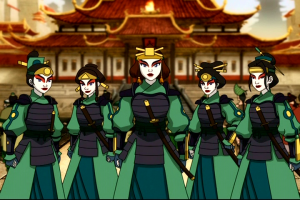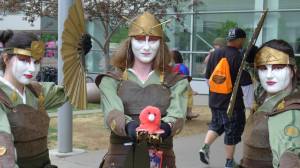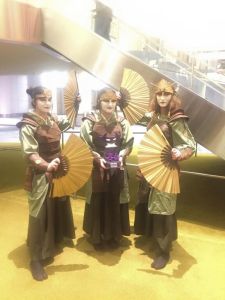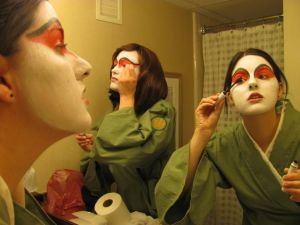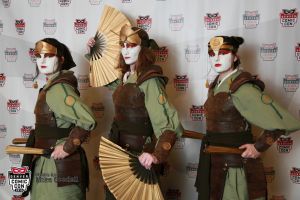I am a cosplayer. My tools are grommets, super glue, papier-mâché and anything else that might not fit into your average conception of a sewing kit. I spend hours hunching over fabric, ripping out miles of seams, and brainstorming ways to defy physics. When I step onto the floor of the convention hall, I wear a disguise that tells everyone exactly who I am.

Photo by Ariane Peveto
The word cosplay, a portmanteau of “costume” and “play,” is much more than a Halloween costume or dressing up. When someone builds a cosplay and wears it, it speaks to who she is, what kind of person she wants to be. A cosplayer’s job is to become a character. To put on not only that character’s clothes, but also mannerisms and demeanor.
There is a huge difference between buying a bagged costume and creating a functioning set of angel wings using a mad-scientist fusion of PVC pipe and crepe, between making do with available sizes and getting pricked so many times with a needle that the outfit could be a blood relative.
Through design, construction, and ultimately wearing the outfit, cosplay is a process of becoming.
I have made several costumes and competed many times, but nothing stretched my abilities as much as when I decided to become a Kyoshi warrior with my sister and a friend. The Kyoshi warriors are a band of fighters from the television show Avatar: The Last Airbender. They dress in emerald tones of the Earth Kingdom, don samurai-like armor and brandish fighting fans to serve and protect. They are skilled fighters, known and respected throughout their world as peacekeepers. They are defined by their devotion to honor, justice — and above all: no boys allowed.
In the show there are many iconic characters, but the Kyoshi warriors are some of the best: not only do they look awesome wielding their dual fans but they are also solid characters that help the protagonists in their journey.
As with any occasion where dress is stressed, there are certain expectations of female cosplayers, and not all of them are positive. Comic books, television shows, and other media have long set forward a standard of tight, unrealistic, or revealing clothing, as well as the “ideal” thin and trim body type for women. Because of this, female cosplayers often have to deal with unwanted attention and even harassment based on how they choose to dress.
It’s because of this that the slogan “Cosplay is not Consent” has recently become a loud voice in convention hallways, fighting the idea that female cosplayers have to accept inappropriate behavior because of what they’ve decided to wear. Sadly, at the convention, a place that should be a nonstop celebration of creativity, not everyone holds the same respect for his or her fellow cosplayer.
The Kyoshi warriors and their long skirts, robes, and armor certainly don’t fit into the mold of pinup models, but that made it all the more important to me that we do our very best to represent these characters well.
We were excited to embark upon this project. Each member of the Kyoshi warriors has variations to her uniform—a design on the headband, a particular hairstyle—that make her unique, so it was easy for each of us to create our own warrior.
Conceptually the outfit was simple, but conversion from two-dimensional animation to three-dimensional reality presented a few hurdles. After running our hands over every bolt of fabric in every fabric store in town, we decided on colors, and guesstimated how much we might need. Patterns were cannibalized and adapted to create the right look for the long, full skirts and robes that would be worn under the armor. For that, we cut out craft foam and covered it with faux leather, overlapping several pieces to make panels. We made molds for round seals that would be superglued to the gauntlets and painted them gold. For the headbands, we treated craft foam with several layers of watered-down craft glue to make it stiff and then buffed gold paint onto the designs.
These costumes went through several renditions after being tested at a few conventions. We made revisions so that the armor took on the more fitted, feminine shape that the show has, and probably most importantly, so we could actually sit down while wearing the outfit.
Despite some cosmetic changes, our cosplay made an impact the first day it was worn. People noticed us the moment we stepped out of the elevator and we couldn’t move for ten minutes while our picture was taken by over fifty people. Everywhere we went, someone asked for a picture. Our fighting fans, made for performances, create a powerful snap when opened with a sharp flick of the wrist. Every time we stopped to pose, fans snapping open in unison, the sound would call to people all over the convention. Our presence was certainly noticed! We could hardly walk anywhere without being stopped for a photo, and as we started to move again, a girl in cat ears or a cosplay Spiderman would hold up a finger, international convention language meaning “Okay if I take one more?”
As we moved through the halls, people responded to us. They straightened up and changed conversations, getting their act together while the Kyoshi warriors were on the scene. This is the magic of cosplay—when you bring something fictional into the world and pour yourself into it, people cannot help but react as if it’s real. Even though I knew I was just a simple college student, as people instinctively moved aside or respectfully made way, I felt like a true enforcer of justice.
It was not until Denver Comic Con 2015 that we decided to compete with this cosplay. Costume judging and stage performance—or craftsmanship and the masquerade as cosplayers call them—are an essential part of a convention, and this year, we wanted to see how our work would stand up to the judges’ criteria. We finished our third revision days before my sister and I drove up to Denver with a stuffed garment bag, and a box filled with gauntlets, headbands, and tabi boots.
Getting dressed in the costume is a serious undertaking. The face paint is by far the longest part of the process. After gluing our eyebrows down with spirit gum and wax, we applied white makeup, with red and black accents around our eyes. It takes at least one other person to help put on the armor, strapping on the gauntlets, threading and tying off the armor laces, and fastening the shoulder pieces.
That afternoon, by the time the last headband was tied on, we were almost late for our craftsmanship judging timeslot. We ran through the hotel, across the street and into the convention center. We darted through the crowds of Marios, ninjas, princesses, and superheroes on a mission, our faces set. People turned as we blew by, nudging their neighbors, squealing with delight, whispering, “Kyoshi warriors!” I couldn’t help but smile. We were being recognized again.
Judging as a rule, is always running late, so we had a minute to pull ourselves together before we were ushered inside. Three judges sat behind a long table. One of them, a lady in a classic Batgirl costume, said, “You guys look great!”
The other two were more reserved. They asked us a lot of questions about the process of making the outfits, what the armor was made of, how long it took to make them. As they looked at the sample pictures we provided on a tablet, we explained our creative decisions—choosing sage and forest green instead of jewel tones, crafting the armor with stamped brown leather to fit better with the organic colors of the Earth Kingdom, etc. They nodded through our explanations and asked to look at our hems and our fans.
They thanked us for coming in and as we left, one of the judges asked if we had a walk-on performance in the masquerade. We told her we did and she answered, “If you didn’t, I’d say go make something up right now.” The other two judges laughed and agreed.
Later, we sat in the green room while the masquerade organizers got everyone in order. We got to talk with a lot of the other competitors and ask them about their cosplays. One group had six people, dressed in elegant Viking-inspired outfits—the young woman seated near us explained that she had just been married and this was their wedding party. I got to talk with a corpse bride who was competing for the first time.
The masquerade is a different animal than craftsmanship. It is one thing to construct an outfit, build a suit of mech armor or craft dragon wings; it is another to get up on a stage in front of hundreds of people and convince them what they are seeing is real. Every movement and gesture will be under scrutiny by hundreds of devoted fans. The cosplayer selects music to play during her three minutes of performance. There might be a funny skit with exaggerated gestures, an interpretive dance, a gymnastic routine, or something else completely. The audience never knows what will come next.
Backstage we could see the silhouettes of the performers on the thin white scrim that separated us, shadows of what was to come. From the noise of the crowd, we could tell the room was massive and packed. At last, the three of us mounted the stairs and walked out from stage right as the MC announced the Kyoshi warriors.
Through the glare of stage lights and nerves, I could see hundreds of people stretching away out into the dark. They were cheering so loud, I barely realized our music had started without us.
We caught up with our choreography, which was a martial arts kata (training exercise routine) with fan forms put to music. Over the music, we’d put narration of our own voices.
“We fight for our people.” My voice sounded strange as it fell over the crowd.
“We fight for justice.” My friend executed a perfect fan form.
“We fight to protect this land.” My sister gracefully turned.
Together, we stood at attention. “And we fight,” we said in unison, “like girls.”
At that, we snapped open our six fans like an explosion of gold fireworks, and the roar of the crowd was deafening.
I don’t remember the rest of the performance. Suddenly, we were finishing with a bow and I looked up at the hundreds of people who couldn’t clap hard enough. Shakily, I crossed the stage to the stairs and we walked to our chairs at the back of the room.
During the intermission, so many people came up to us. Most of them were girls or young women, coming to say how much they enjoyed our performance.
“It was so cool! The thing you do with the fans,” one lady said, shaking her head.
“So awesome,” one young man said, throwing two thumbs up.
Several competitors told us the same, and because of the overall high level of dedication and creativity we’d witnessed, that was a high compliment.
Another woman stopped us to ask, “Have you taken martial arts?” She said that our performance was the first one featuring martial arts that didn’t make her wince.
“If you don’t win,” said one girl, “I’ll throw up.”
I couldn’t believe how many people talked to us. They kept saying how incredible it was. Some even looked teary. Several said they had been moved by what we had done.
Perhaps we surprised them.
As we talked with our fellow con goers I was beaming from ear to ear, despite knowing it was probably wrecking havoc on my face paint. After hearing what they all had to say, it didn’t matter if we won anything. Those compliments were more than enough.
There were several awards given for judge’s favorites, and special awards for different categories. We had seen the competition and there were so many incredible outfits, detailed cosplays, and thoughtful performances. I agreed with everyone who won craftsmanship or performance in their category, and clapped as loudly as anyone for the novice couple who wowed us with their fantastic Aquaman and Mera cosplay. No one could believe it was their first competition.
Our threesome competed at the intermediate level, which had the most contestants. The craftsmanship and performance awards in our category went to other well-deserving cosplayers. When the judges began describing the best group cosplay, I thought they might be talking about us, but that award went to the group ahead of us that did an acrobatic display. Last but not least was Best in Show—the award given for the best craftsmanship and performance. The spokesperson for the judges, the lady in the classic Batgirl costume, started talking about how impressed they had been by the choices made by this group, the quality of the work, and then an amazing stage performance.
“I think no one is surprised,” she said, looking out at the crowd.
The Kyoshi warriors won Best in Show!
The screaming around me was so loud that it ceased being sound at all. Bewildered and awed, we made our way up to the stage. The judge held out the trophy and being the closest, I took it without believing what I was doing. My compatriots were loaded down with our bags of posters, books, and other convention loot. We bowed, thankful to the audience, the judges, and for such an incredible experience. The cheering was so loud my ears rang.
To this day I still can’t believe that we won, but the trophy is here sitting on my desk. I’m honored to be part of a corps of creative engineers who come away from reading books, watching movies, and playing games thinking, “How can I make that outfit?”
I am still overwhelmed by the positive response we got. We showed them what we could do with our tools, our eyelets, lacing and craft foam, our imagination, time and passion. Even people who didn’t know what we were, recognized something in how we took the floor.
Three young women, three warriors, made a difference to so many people.
Editor’s Note: The 2015 Denver Comic Con received a tidal wave of negative media and social media attention because of a “Women in Comics” panel taking place, with no women on it. In contrast to that spin coverage, started from one small, though important event oversight (there were over 400 panels during the 3-day convention), this story covers a bigger part of the gathering.
As well the excellent article below gives a balanced perspective of the convention from one of its organizers, a long-time woman in comics:
I believe the strong feelings and reactions to this issue of women in comics reflects its critical importance. Accurate, honorable and creative representation of women and all people should in fact generate widespread and thorough discussion.
